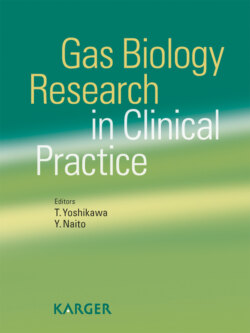Читать книгу Gas Biology Research in Clinical Practice - Группа авторов - Страница 10
На сайте Литреса книга снята с продажи.
CO Derived from HO-1 in Macrophages
ОглавлениеCO is a nonradical gaseous mediator generated by a mono-oxygenase reaction through heme oxygenase (HO). It was first shown in the early 1970s that both nonparenchymal cells and hepatocytes enable the degradation of heme to bile pigments. Kupffer cells play a role in the removal and degradation of senescent erythrocytes, while hepatocytes catabolize free heme derived from hemoglobin or cytochromes P450 [1]. Distribution of HO-1 and HO-2 in the liver was previously examined by our laboratory in rats and humans, indicating that the two isozymes have distinct topographic patterns: HO-1, the inducible form, is prominent in Kupffer cells, while the constitutive HO-2 is mostly abundant in hepatocytes [2, 3]. Our studies using a specific monoclonal antibody against HO-1 that blocks the isozyme activity revealed that approximately 70% of the whole HO activity in this tissue is derived from HO-2 [3]; considering the percentage of the cell population of Kupffer cells in the liver, these cells possess huge amounts of HO activity as compared with hepatocytes.
Not only in the liver but also in other organs, resident macrophages constitute a major site of the HO-1 distribution. To better understand the tissue iron overload and anemia previously reported in a human patient and mice that lack HO-1, recent studies examined iron distribution and pathology in HO-1(-/-) mice [4], indicating that resident splenic and liver macrophages were mostly absent in HO-1(-/-) mice. This study suggested that erythrophagocytosis causes death of HO-1(-/-) macrophages in vivo and release of nonmetabolized heme likely caused tissue inflammation. In the spleen, initial splenic enlargement progressed to red pulp fibrosis, atrophy and functional hyposplenism in older mice, recapitulating the asplenia of an HO-1-deficient patient which was previously reported in Japan [5]. During constitutive erythrophagocytosis, HO-1-deficient macrophages including Kupffer cells appeared to exhibit cell death by themselves. This study also postulated that failure of tissue macrophages to remove senescent erythrocytes led to intravascular hemolysis and increased expression of hemopexin and haptoglobin, the heme and hemoglobin scavenger proteins, in the liver. Lack of macrophages expressing the Hp receptor, CD163, diminished the ability of Hp to neutralize circulating Hb, and iron overload occurred in kidney proximal tubules, which were able to catabolize heme with HO-2. Thus, in HO-1(-/-) mammals, the reduced function and viability of erythrophagocytosing macrophages appear to be the main causes of tissue damage and iron redistribution.
